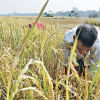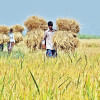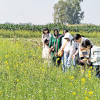From subsistence to commercial farming
On a Friday at a farmers' market in Dhaka, 23-year-old Moazzem Hossain was sitting behind a display of eggplants, pointed gourd, carrot, lettuce, Chinese cabbage and a bundle of celery, a lesser-known leaf among Bangladeshis.
If anyone enquired, he would answer politely and even say that celery is used to prepare juice and is becoming popular among middle-class people in the metropolis, the political and economic capital of the country.
Celery is the latest addition to the vegetables his father, Md Rafiz Uddin, grows on more than one acre of leased land at Moshurkhola, a village in Savar, more than 20 kilometres west of Dhaka.
Last winter, Rafiz and his son regularly brought beetroot, Chinese cabbage and red cabbage alongside popular vegetables like eggplant, green chilli and bottle gourd to the farmers' market every Friday to sell directly to customers.
Just beside Moazzem sat Nur Mohammad, another farmer who brings produce from Narsingdi every day. Meanwhile, some of their mates come from the Manikganj, Munshiganj and Sylhet districts to sell their fresh fruits and vegetables.
"All the vegetables I grow are for selling at the market," said the 78-year-old Rafiz.
It has been two and a half decades since the elderly farmer has been cultivating vegetables, mostly alien and high-value, to sell at the market and thereby make a living for his four-member family.
"I worked at a private real estate company. I left the job in 1997 and signed up for farming a year later. I began with broccoli by bringing seeds through a non-resident Bangladeshi who lives in the US," he said.
His inspiration came from Karwan Bazar, one of the largest wholesale and kitchen markets in Dhaka city, which is home to over one crore of the country's population, as per the Bangladesh Bureau of Statistics.
In his own words, broccoli was selling at a high price, so he leased half a bigha of land in Savar and made a huge profit in the first year. At that time, broccoli was grown in Gazipur, but it was not of good quality.
As the broccoli grown in Savar got a good response from traders in Karwan Bazar, Rafiz expanded its cultivation to two bighas the next year, he said, while walking along the alleys of fields with diversified crops, ranging from paddy to various high-value crops planted to sell at the market.

The leased land of Rafiz bears lettuce, beetroot, celery, Chinese cabbage and Chinese onion alongside some popular and seasonal vegetables, such as eggplant and pumpkin.
At the turn of the year 2000, only a few farmers in his area would cultivate vegetables to sell at the market, as most grew vegetables for their own consumption.
"Today, a lot of farmers cultivate vegetables to sell at markets in Dhaka," he said.
"You will see tonnes of vegetables are shipped daily from here to markets in Dhaka and other parts," Rafiz added.
However, Savar is not the only place where farmers are growing crops for commercial purposes.
Elsewhere in the country, from the north-western bordering district Panchagarh to the southern coastal district Patuakhali, farmers grow multiple crops to sell at markets, a trend which was not common in the 1960s and 1970s.
Farmers used to grow food for subsistence at that time. But their interest in cultivation gradually grew thanks to the introduction of improved seeds, namely high-yielding varieties, and the availability of subsidised fertilisers, agricultural extension services and policy support.
Besides, the steady economic growth and rising demand for food in cities due to rapid urbanisation, increasing agricultural processing, and the spread of cold storage facilities have given impetus to growers.
"The road communication infrastructure has increased alongside markets. Farmers are also producing surplus crops," said Abdul Bayes, a former professor of economics at Jahangirnagar University.
"Overall, we are moving towards commercial agriculture from subsistence farming," said the economist, also a former vice-chancellor at Jahangirnagar University.
M Asaduzzaman, a former research director at the Bangladesh Institute of Development Studies (BIDS), supported this view.
"Once, people would collect water spinach from waterbodies such as ponds. Now it is grown commercially," he said. "You see, dragon fruit and broccoli are grown almost everywhere. A form of agricultural entrepreneurship has emerged."
Crops are not the only area where commercialisation -- selling of surplus produce to markets -- is taking place. Gone are the days when domestically reared livestock met demands for animal protein.
Commercially grown poultry meets most of the requirements for meat and eggs, while aquaculture accounts for nearly 60 percent of the locally produced fish, reflecting the demand for farmed fish.
Likewise, dairy farming to produce milk and beef is expanding.
Akhter U Ahmed, country representative for the International Food Policy Research Institute (IFPRI), Bangladesh, said commercialisation of agriculture means shifting farming from mainly growing food for the farmer's own use to growing crops and raising livestock mainly for sale at markets.
"Agricultural commercialisation is measured by the marketed surplus rates for major crops. Marketed surplus refers to the share of a farmer's total production that is sold at markets," he added.
In Bangladesh, agriculture is becoming more commercialised, moving beyond traditional subsistence farming. Other than producing rice, farmers are now growing more cash crops like vegetables, fruits, flowers, and raising poultry and fish for commercial gain.
The IFPRI found that in the case of rice, the amount of marketed surplus is 56 percent while it is more than 80 percent for vegetables and fruits.
These findings come from estimates on the rates of agricultural commercialisation using data from the 2018-19 Bangladesh Integrated Household Survey, a national representative sample covering rural areas across the country.
"Before independence, most farmers grew fruits like mango for personal consumption. But commercial farming of fruits and vegetables has increased over time," Ahmed said.
The intensity of commercial and diversified farming is high in areas that have good market access and are in close proximity to big cities like Dhaka.
"If you go to Narsingdi, you will see trucks lined up at dawn loading fresh produce to transport to various other districts," he said. "If you go to north Bengal, you will find banana orchards."
The landscape changed after the construction of the Jamuna Bridge, which connects the north-west with Dhaka.

"The main driver is good roads and transportation. Before the Jamuna Bridge, there was not much commercial farming in the Bogura-Rangpur regions. And after the construction of the Padma Bridge, commercial farming increased in southern and south-western regions," Ahmed added.
Analysts said commercial farming has increased farmers' incomes and helped many small growers come out of poverty. However, challenges remain.
A diagnostic study on Bangladesh agriculture co-authored by Mahabub Hossain, Abdul Bayes and Prof SM Fakhrul Islam identified a number of problems faced by the country's small and marginal farmers.
These include limited market access due to small production volumes, high post-harvest losses, inadequate storage and transportation, lack of cold chain facilities, food quality and safety problems, and inadequate credit.
The working paper also identified a lack of processing facilities and low output prices.
"Marketing is the main problem. Fair prices for farm produce must be ensured," said former BIDS research director Asaduzzaman.
The salient features of agricultural product markets are poor infrastructure, with a lack of storage and processing facilities, poor roads and communication, and unfair practices of middlemen, according to a diagnostic study on domestic agriculture.
"Marginal and small farmers are often facing the problem of marketing their products and are not getting fair prices due to the existence of trade syndicates," it said.
The paper, published by the BRAC Institute of Governance and Development (BIGD), said that in Bangladesh, small farms account for 96 percent of operational holdings with a share of 69 percent of cultivated area.
"Most poor farmers are not linked to markets for a variety of reasons: remoteness, low production, low farm-gate prices, and lack of information, to name a few," it added.
Bayes said small farmers are key players, and they are responding to market demand. So, their issues must be addressed.

FOOD SAFETY CONCERNS
However, the growing commercialisation of farming has created concerns about food safety and quality. Post-harvest management and quality assurance are other issues to increase agricultural production.
The BIGD paper said horticultural crops in Bangladesh are prone to heavy doses of contamination with toxic chemicals, foodborne bacteria and pathogens due to exposure to indiscriminate spraying of chemicals.
"As high-value product value chains are more demanding in food safety and quality standards, greater attention is required for certification and quality enforcement for both inputs and outputs, and for adherence to quickly changing standards," it added.
IFPRI's Ahmed said small and fragmented landholdings limit farmers' ability to invest in modern technologies and achieve economies of scale.
Furthermore, limited access to affordable credit and insurance restricts farmers' capacity to take risks and adopt high-value crops or improved production practices.
Additionally, weak agricultural extension services and a lack of updated market information prevent farmers from making informed production and marketing decisions.
Despite these challenges, he said, there are significant opportunities for promoting commercialisation.
"Growing domestic demand for diversified and high-value food products, such as poultry, vegetables, fruits and flowers, creates strong market incentives," he said. "Advances in technology, including improved seed varieties, mechanisation, and digital platforms for market access, can enhance productivity and profitability."

The BIGD working paper said government initiatives and support will be required to develop marketplaces, market outlets and farmers' groups.
It highlighted that credit facilities would be required to promote private initiatives for small and medium-scale agribusinesses in processing and packaging.
"Formation of farmers' groups with enhanced access to credit will be needed to encourage their direct participation in marketing. A fair price for agricultural crops and products must be ensured," it added.
IFPRI's Ahmed said the increasing role of the private sector, including contract farming, input supply companies and agri-processing industries, offers pathways for integrating smallholders into modern value chains.
Also, strengthening farmer organisations and cooperatives can further improve their bargaining power and market access.
"Finally, Bangladesh's strategic geographic position offers opportunities for regional trade expansion, particularly in south and southeast Asia."
Rafiz said the cost of farming has increased over time.
"Farm labour is becoming scarce. The land lease cost has risen, too. When we go to Karwan Bazar to sell our produce, we have to spend extra on extortion. This must stop," he added.

 For all latest news, follow The Daily Star's Google News channel.
For all latest news, follow The Daily Star's Google News channel. 




Comments